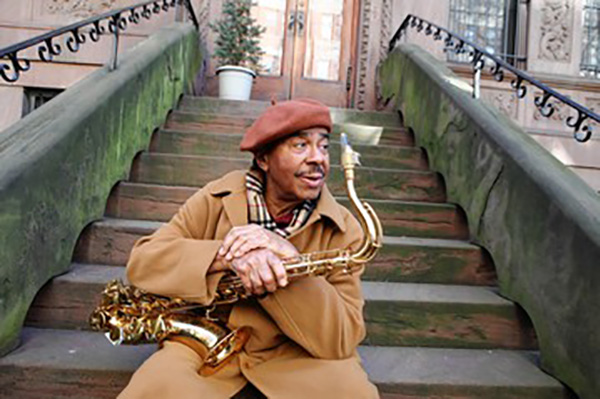Wall Street Journal
February 9, 2012
Serving That Uptown Sound
By Marc Myers
 Benny Golson sits on the stoop of the famous Harlem brownstone where the photograph A Great Day in Harlem was taken in 1958 by Art Kane.
Benny Golson sits on the stoop of the famous Harlem brownstone where the photograph A Great Day in Harlem was taken in 1958 by Art Kane.
Back in 1959, tenor saxophonist Benny Golson lived at 55 W. 92nd St., in apartment 4J. To lock up his family's baby carriage in the common hallway, he hammered a steel plate and eyebolt into the base of the wall just outside his front door. That eyebolt is still there.
"You're kidding!" said Mr. Golson, who will appear with a quartet from Thursday through Sunday at Jazz Standard—only his second appearance there in about 10 years. "That takes me back. I wrote several of my best-known songs in that apartment between 1959 and 1962. Quincy Jones lived there, too, in apartment 6H."
Mr. Golson is widely considered among jazz's most prolific living composers, and heir to Billy Strayhorn and Tadd Dameron's sensual-sophisticated style. At least a dozen of his estimated 300 published songs—including "Stablemates," "I Remember Clifford," "Are You Real?" and "Whisper Not"—are standards, having been recorded by hundreds of jazz and pop artists.
At 83 years old, Mr. Golson is still busy. Later this month he'll travel to Nashville to record with country singer-songwriter Gail Davies. Then he'll head out on a 12-city club tour before returning to Jazz at Lincoln Center in late March for a gathering of tenor-sax titans. In April, he'll perform a newly commissioned jazz work at the August Wilson Center for African American Culture in Pittsburgh.
Although his home on West 98th Street is now just one of three he keeps—the others are in Los Angeles and a small town outside Munich—many of his most popular compositions were written here in New York, including "Five Spot After Dark," "Killer Joe," "Blues March," "Park Avenue Petite" and "Along Came Betty."
Serving That Uptown Sound
By Marc Myers
 Benny Golson sits on the stoop of the famous Harlem brownstone where the photograph A Great Day in Harlem was taken in 1958 by Art Kane.
Benny Golson sits on the stoop of the famous Harlem brownstone where the photograph A Great Day in Harlem was taken in 1958 by Art Kane.Back in 1959, tenor saxophonist Benny Golson lived at 55 W. 92nd St., in apartment 4J. To lock up his family's baby carriage in the common hallway, he hammered a steel plate and eyebolt into the base of the wall just outside his front door. That eyebolt is still there.
"You're kidding!" said Mr. Golson, who will appear with a quartet from Thursday through Sunday at Jazz Standard—only his second appearance there in about 10 years. "That takes me back. I wrote several of my best-known songs in that apartment between 1959 and 1962. Quincy Jones lived there, too, in apartment 6H."
Mr. Golson is widely considered among jazz's most prolific living composers, and heir to Billy Strayhorn and Tadd Dameron's sensual-sophisticated style. At least a dozen of his estimated 300 published songs—including "Stablemates," "I Remember Clifford," "Are You Real?" and "Whisper Not"—are standards, having been recorded by hundreds of jazz and pop artists.
At 83 years old, Mr. Golson is still busy. Later this month he'll travel to Nashville to record with country singer-songwriter Gail Davies. Then he'll head out on a 12-city club tour before returning to Jazz at Lincoln Center in late March for a gathering of tenor-sax titans. In April, he'll perform a newly commissioned jazz work at the August Wilson Center for African American Culture in Pittsburgh.
Although his home on West 98th Street is now just one of three he keeps—the others are in Los Angeles and a small town outside Munich—many of his most popular compositions were written here in New York, including "Five Spot After Dark," "Killer Joe," "Blues March," "Park Avenue Petite" and "Along Came Betty."
"That last one I composed in 1958 at Graham Court on 116th Street and Seventh Avenue," he said. "I lived in apartment 7H at the time—my aunt's place and my first apartment in New York after moving up from Philadelphia in 1956."
Who was Betty?
"Betty was Betty Pritchet—she came into a Dayton, Ohio, club where I was playing in 1951 and caught my eye. Shortly after I met her, Betty began visiting me regularly in New York. In 1958 I sat down at the green and black upright piano in my apartment and wrote the song. Its rhythmic sway reflects how Betty used to walk."
When Mr. Golson joined Art Blakey and the Jazz Messengers that same year, "Along Came Betty," as well as Mr. Golson's "Are You Real?" and "Blues March" were featured on "Moanin'," one of Blakey's top-selling Blue Note albums.
"When I originally told Art [Blakey] about my idea for a march, he thought I was crazy," Mr. Golson recalled. "Art said, 'Nobody plays a march except at a New Orleans funeral.' I told him I was thinking of a dirty, funky, greasy, march—like the ones played at football games by black college marching bands."
When Mr. Golson finished writing the march, he auditioned it for Blakey. The drummer wasn't moved. "Days later we were at Small's Paradise on Seventh Avenue at 135th Street in Harlem," he said. "I decided we should try it out live. There was no dancing allowed up there. Space was tight. But as soon as the one-two beat began, everyone got up to dance anyway, knocking drinks off tables. Art looked over at me and said, 'Well I'll be damned.' After that, Art and the Messengers played 'Blues March' all the time."
Perhaps Mr. Golson's most famous New York song is "Killer Joe," which he composed in 1959, inspired by "the many suave pimps I had seen hanging out at jazz clubs, particularly at the old Birdland."
More than 50 years after he wrote "Killer Joe" in his former 92nd Street apartment, Mr. Golson said he still looks forward to playing it live, as he has done in countless clubs, from New York to Indonesia.
"I think the audience will still remember it after the first few notes," he said.
Who was Betty?
"Betty was Betty Pritchet—she came into a Dayton, Ohio, club where I was playing in 1951 and caught my eye. Shortly after I met her, Betty began visiting me regularly in New York. In 1958 I sat down at the green and black upright piano in my apartment and wrote the song. Its rhythmic sway reflects how Betty used to walk."
When Mr. Golson joined Art Blakey and the Jazz Messengers that same year, "Along Came Betty," as well as Mr. Golson's "Are You Real?" and "Blues March" were featured on "Moanin'," one of Blakey's top-selling Blue Note albums.
"When I originally told Art [Blakey] about my idea for a march, he thought I was crazy," Mr. Golson recalled. "Art said, 'Nobody plays a march except at a New Orleans funeral.' I told him I was thinking of a dirty, funky, greasy, march—like the ones played at football games by black college marching bands."
When Mr. Golson finished writing the march, he auditioned it for Blakey. The drummer wasn't moved. "Days later we were at Small's Paradise on Seventh Avenue at 135th Street in Harlem," he said. "I decided we should try it out live. There was no dancing allowed up there. Space was tight. But as soon as the one-two beat began, everyone got up to dance anyway, knocking drinks off tables. Art looked over at me and said, 'Well I'll be damned.' After that, Art and the Messengers played 'Blues March' all the time."
Perhaps Mr. Golson's most famous New York song is "Killer Joe," which he composed in 1959, inspired by "the many suave pimps I had seen hanging out at jazz clubs, particularly at the old Birdland."
More than 50 years after he wrote "Killer Joe" in his former 92nd Street apartment, Mr. Golson said he still looks forward to playing it live, as he has done in countless clubs, from New York to Indonesia.
"I think the audience will still remember it after the first few notes," he said.






